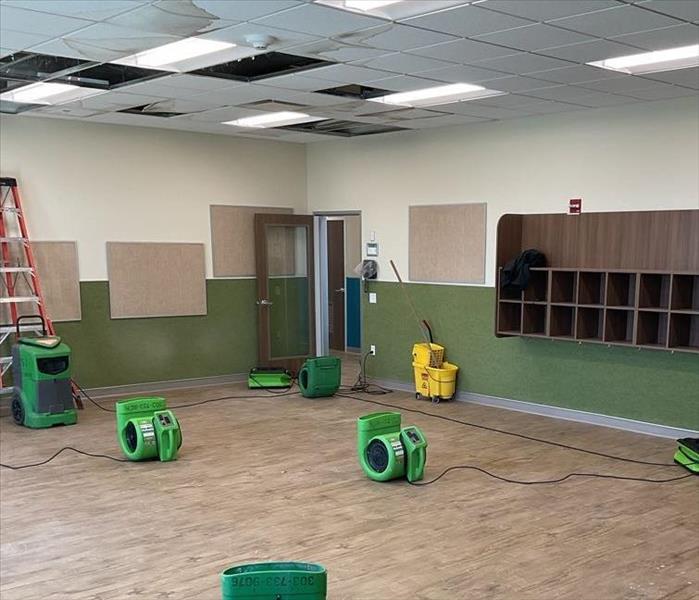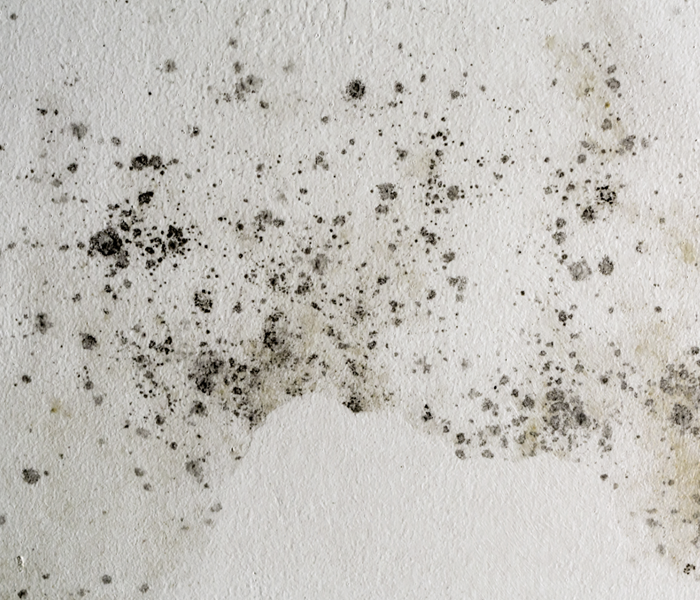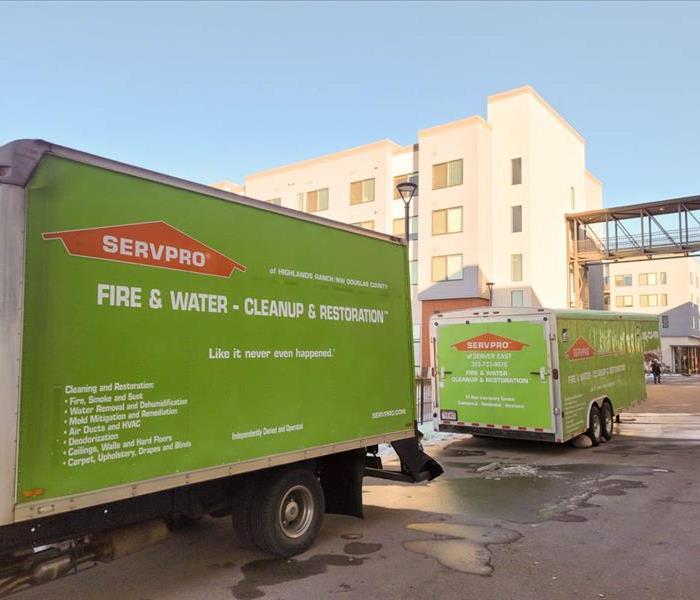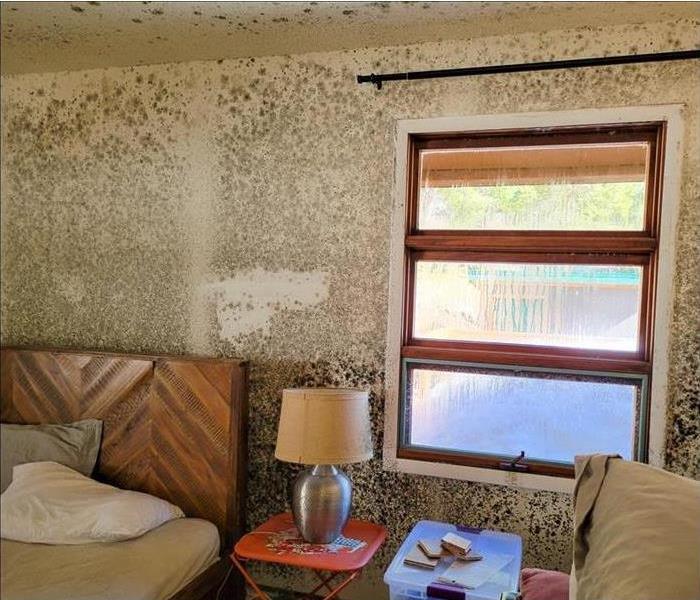Recent Mold Remediation Posts
Mold in Your Attic: Causes, Signs, and Remediation Solutions
3/13/2024 (Permalink)
 Are you experiencing a musty smell in your home? You may have mold in your attic!
Are you experiencing a musty smell in your home? You may have mold in your attic!
Are you experiencing a musty smell in your home? Have you noticed damp spots or discoloration in your attic? If so, your home might be suffering from mold damage, especially in your attic. Mold in the attic is a common problem, but it can be harmful to your home and family. In this article, we discuss the causes, signs, and remediation solutions to help you keep your attic – and home - clean and safe.
Causes of Mold in Attic
Mold growth thrives in moist and humid conditions. Your attic can provide the ideal environment for the mold to grow. Some of the contributing factors include:
- Roof leakage or Storm Damage: If there is an opening in your roofing, rainwater from storms can penetrate your attic, leading to moisture accumulation.
- Inadequate Ventilation: Poor airflow can cause moisture to build up, which can contribute to mold growth.
- Condensation and moisture: Moisture accumulation can result from, among other things, poor insulation, hot air from your heating system, or even humid air from your kitchen and bathroom.
- High humidity levels: High humidity results from damp basements or high condensation, leading to mold growth.
Signs of Mold in Your Attic
Detecting mold damage in your home can be daunting. Here are a few indicators you should observe to identify mold damage:
- Discoloration: Mold tends to grow in wet areas and usually appears as dark spots or patches on your attic walls and ceiling.
- Smell: A musty odor signifies the presence of mold in your attic.
- Visible growth: Greenish-black spores or visible mold may be seen growing on surfaces in your attic.
- Water damage: Water leaks or stains on the walls and ceiling indicate dampness or moisture accumulation that promotes mold growth.
Mold Remediation Solutions
If you detect the presence of mold in your attic, don't panic. With the following remediation solutions, you can effectively tackle mold growth in your attic:
- Inspect and Assess the Extent of the Mold Damage: Look at the extent of the damage to know the severity of the mold contamination in the attic.
- Determine the Source of Moisture: Identify the cause of the mold growth, such as roof leakage, high humidity levels, or inadequate ventilation.
- Experts evaluation: Seek the expertise of SERVPRO® professional mold remediation services. Our team will evaluate the mold damage and advise on how best to approach the problem, ensuring that you tackle the source of the moisture issue to prevent future mold growth.
- Removal of Mold-Damaged Materials: SERVPRO® experts will remove moldy materials damaged by moisture or water promptly.
- Cleaning and Treatment: SERVPRO® professionals will thoroughly clean and treat surfaces affected by mold growth, ensuring no traces of mold spores.
- Drying of Materials: Our experts will dry the materials affected by the mold growth to prevent future contamination.
Fight Against Mold Damage
Mold damage in your attic can be harmful to your home. Early identification and remediation of mold are the keys to avoiding disastrous effects. Keep an eye on any discoloration, water stains, or musty smells in your attic to detect the presence of mold. Address any moisture issues immediately and rely on SERVPRO® professional mold remediation services for a thorough evaluation of the mold damage. By working with our experts, you can ensure that your attic and entire home are safe and healthy environments to live in. Contact us to schedule your Mold Remediation appointment today!
The Science Behind Mold Growth: Ideal Conditions and Spores
10/19/2023 (Permalink)
 Mold growth can leave your home in a mess. Understanding the science behind mold can give you knowledge to proceed incase of mold damage.
Mold growth can leave your home in a mess. Understanding the science behind mold can give you knowledge to proceed incase of mold damage.
Mold growth is a natural process that occurs in various settings. Understanding the science behind mold growth is essential for homeowners to prevent and address this common issue. In this blog, we will delve into the ideal conditions for mold growth and the role of spores, shedding light on the scientific aspects.
Ideal Conditions for Mold Growth
Mold thrives in specific conditions that provide the necessary factors for its growth. The primary requirements include moisture, a food source, and favorable temperatures. Mold prefers environments with high humidity—around 70% or more—combined with organic materials like cellulose (found in wood, fabrics, or paper) as its nutrient source. Furthermore, mold flourishes in temperatures between 68°F and 86°F. These ideal conditions create an environment where mold can rapidly reproduce and colonize.
The Role of Mold Spores
Mold spores play a crucial role in the life cycle of mold. These microscopic reproductive structures are present in the air both indoors and outdoors. Mold spores are carried through the air and can settle on surfaces. They can endure unfavorable conditions until they find an ideal environment to germinate and form new mold colonies. Spores are extremely resilient and can survive in various environments, allowing mold to spread and establish new growth areas, especially when the suitable conditions are met.
Factors Influencing Mold Growth
While moisture, food sources, and temperature are the primary factors that enable mold growth, other elements can also influence its development. Poor ventilation and inadequate air circulation contribute to trapped moisture, creating a more conducive environment for mold. Additionally, lack of sunlight or excessive shade can prevent surfaces from drying properly, promoting mold growth. Understanding these additional factors allows homeowners to implement preventive measures, such as improving ventilation, addressing water leaks promptly, and ensuring adequate sunlight exposure to inhibit mold formation.
Preventive Measures
By comprehending the science behind mold growth, homeowners can be proactive in preventing mold infestations. Regular inspection and maintenance play a vital role. Ensuring proper ventilation, especially in high-moisture areas like bathrooms or basements, helps reduce humidity levels and prevent mold growth. Promptly addressing any water leaks or intrusion prevents excess moisture buildup, while maintaining dry conditions discourages mold from thriving. Additionally, controlling indoor humidity levels with dehumidifiers and promoting proper airflow enhances mold prevention efforts.
Effective Remediation Strategies
In the event that mold growth does occur, understanding the science behind mold can also guide homeowners in implementing effective remediation strategies. It is crucial to address the underlying moisture issue that initially facilitated mold growth. This may involve repairing leaks, improving ventilation, or addressing any sources of excess humidity. When removing mold, proper containment and protection measures should be followed to prevent its spread to unaffected areas. Utilizing appropriate cleaning solutions and techniques, such as scrubbing with detergent or utilizing specialized mold cleaners, can help eliminate mold from surfaces. Regular monitoring and maintenance thereafter can help prevent future mold outbreaks.
Understanding the science behind mold growth equips homeowners with the knowledge to create an environment less conducive to mold development. By recognizing the ideal conditions, the role of spores, and the various factors that influence mold growth, individuals can implement preventive measures effectively, ultimately fostering a mold-free living space.
How to Remove Mold from HVAC Systems and Ducts: A Guide from a Disaster Restoration Expers
5/15/2023 (Permalink)
 By following these steps and being proactive about addressing mold issues, you can keep your home or business safe and prevent costly damage.
By following these steps and being proactive about addressing mold issues, you can keep your home or business safe and prevent costly damage.
As a disaster restoration expert, dealing with mold in HVAC systems and ducts is a common problem that can have serious consequences if left untreated. Mold growth can lead to unpleasant odors, reduced air quality, and structural damage to your home or business. If you suspect that your HVAC system or ducts have mold, it's important to take action as soon as possible to prevent the mold from spreading and causing further damage.
Getting Professional Help
The first step is to have your HVAC system inspected by a professional mold remediation company, such as SERVPRO of Denver East. They can assess the extent of the mold damage and recommend the best course of action. Depending on the severity of the problem, they may recommend cleaning or replacing affected components, or even replacing the entire HVAC system.
Preventing Mold Growth
To prevent mold growth from returning, it's important to take steps to control moisture in your home or business. This may include fixing leaks or water damage, improving ventilation, and using dehumidifiers in areas where moisture is a problem.
Regular Maintenance is Key
Regular maintenance of your HVAC system is also important in preventing mold growth. This may include replacing filters regularly, cleaning ducts and vents, and having your system inspected by a professional on a regular basis.
Why You Need a Professional Mold Remediation Company
It's important to note that attempting to remove mold from your HVAC system or ducts on your own can be dangerous and ineffective. Without the proper equipment and training, you risk spreading mold spores and causing further damage to your HVAC system. This is why it's essential to hire a professional mold remediation company to handle the job.
When choosing a mold remediation company, be sure to do your research and choose a reputable company with experience in HVAC mold remediation. Ask for references and check online reviews to ensure that the company has a track record of success in removing mold from HVAC systems and ducts. By working with a professional, you can ensure that the mold is safely and effectively removed from your HVAC system, preventing further damage and ensuring the health and safety of your home or business.
Preventing Mold Growth in HVAC Systems and Ducts
By following these steps and being proactive about addressing mold issues, you can keep your home or business safe and prevent costly damage. Remember to work with a professional mold remediation company and take steps to control moisture and maintain your HVAC system to prevent mold growth from returning.
3 Signs You Need Mold Remediation
12/16/2022 (Permalink)
 Water damage can lead to mold growth if not treated quickly.
Water damage can lead to mold growth if not treated quickly.
Mold can be a big problem. If you see signs of mold in your home, it's best to get it taken care of as soon as possible. Unfortunately, most people don't know what to look for when they notice a potential mold issue. So how do you know if you need mold remediation? Here are some common signs that may indicate your property has become infested with mold:
1. Strange Smells
If you notice a musty odor in your home, it could be the result of mold. Mold can grow almost anywhere and often has an earthy smell. You may also notice that the smell gets stronger when it's humid outside. If you've noticed a damp or musty odor coming from your basement or bathroom, this could be an indication that something is growing on your walls or ceiling (or both).
2. Recent Water Damage
If you have water damage from a flood or a leak, whether it’s a full-blown flood or just some water collecting on your floor, that could be an indication that mold is growing in your home. The severity of the problem will determine whether or not you need mold remediation.
If you have only one small area of moisture buildup, then there are likely no worries about mold developing. But if you have an entire room filled with standing water, then there's cause for concern.
3. Change in Color
Mold can be a wide variety of colors, ranging from green to brown and black. If you notice that your walls are changing color or are becoming darker than they used to be, this may be a sign that mold is present.
Did you recently find mold on your property?
Mold can appear in a variety of ways, including on the surface of materials or hidden behind walls, in the attic, or even in the basement. It is often difficult to spot and can be tough to identify when it’s growing inside your Glendale, CO home.
Is the problem spreading?
If you've discovered mold in your home, it's important to be aware that it can spread quickly. Mold spores are microscopic and can travel through the air. If mold is growing somewhere in your home, it might be spreading to other areas. Mold spores are small enough to carry around on clothing or shoes; so even though you didn’t go anywhere near where there was visible mold growth before discovering black spots on some items in your closet, there's still a chance those black spots come from something lurking within an unwelcoming corner of some other part of your home!
The best way to prevent this from occurring is by hiring a professional for remediation services as soon as possible after discovering signs of mold growth.
Even small mold problems can become big ones.
Mold is a common problem in humid environments, like bathrooms, kitchens, and laundry rooms. And while it may seem like a small problem at first, it can easily become a big one. Not only does mold cause health problems for you and your family, but if left untreated it can spread quickly throughout your home.
If you see any signs of mold on the walls or floorboards of your home – especially if they smell musty – contact a professional right away. Don't wait until the situation becomes worse!





 24/7 Emergency Service
24/7 Emergency Service



